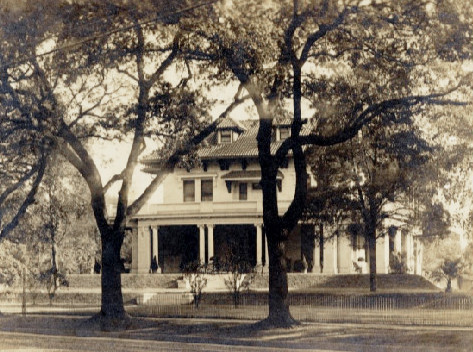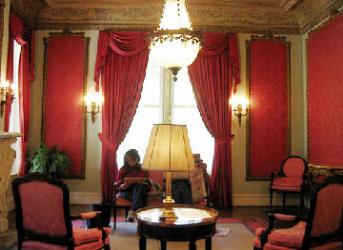
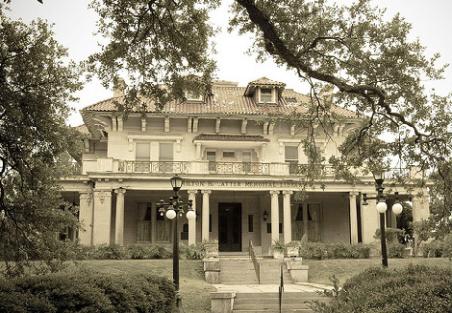
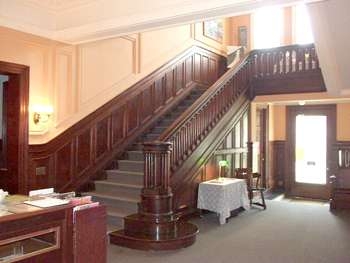























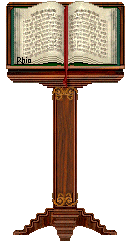
| Milton Latter Library |
It's been said that New Orleans' St. Charles Avenue, lined with its ancient oaks and it grand old
mansions, is one of the greatest boulevards in the country. It would be hard for anyone who's taken a
streetcar ride along the elegant avenue to argue with that. While, sadly, many of the grand old houses on
lower St. Charles, the downtown section of the avenue, have fallen victim to the wrecking ball, most of
the historic homes in the uptown section, from Napoleon Avenue to the bend in the river, have remained
intact. The sheer number of impressive mansions, the history behind them, the varied architecture, the
setting of the avenue itself - with its massive oaks forming a tunnel effect high over the rumbling St.
Charles Avenue streetcar - all of these things make a lasting impression on visitors to this street that
locals often refer to simply as "the avenue."
Of all the beautiful houses on St. Charles Avenue, there's a special place in my heart for one I visited
often during my childhood and teenage years, the Milton H. Latter Memorial Library branch of the New
Orleans Public Library. It's not only the most elegant library in the city, but, as far as I know, it's the
only mansion on the avenue that the public is invited to visit. The original grandeur of the home has been
faithfully preserved during its incarnation as a library. An afternoon spent in one of its reading rooms is
a magical afternoon in a bygone era. The success of the preservation and restoration lies in the fact that,
when there, you tend to think of it as a home, instead of a library. And the home it once was has an
interesting history.
mansions, is one of the greatest boulevards in the country. It would be hard for anyone who's taken a
streetcar ride along the elegant avenue to argue with that. While, sadly, many of the grand old houses on
lower St. Charles, the downtown section of the avenue, have fallen victim to the wrecking ball, most of
the historic homes in the uptown section, from Napoleon Avenue to the bend in the river, have remained
intact. The sheer number of impressive mansions, the history behind them, the varied architecture, the
setting of the avenue itself - with its massive oaks forming a tunnel effect high over the rumbling St.
Charles Avenue streetcar - all of these things make a lasting impression on visitors to this street that
locals often refer to simply as "the avenue."
Of all the beautiful houses on St. Charles Avenue, there's a special place in my heart for one I visited
often during my childhood and teenage years, the Milton H. Latter Memorial Library branch of the New
Orleans Public Library. It's not only the most elegant library in the city, but, as far as I know, it's the
only mansion on the avenue that the public is invited to visit. The original grandeur of the home has been
faithfully preserved during its incarnation as a library. An afternoon spent in one of its reading rooms is
a magical afternoon in a bygone era. The success of the preservation and restoration lies in the fact that,
when there, you tend to think of it as a home, instead of a library. And the home it once was has an
interesting history.
It was designed by architects Favrot and Livaudais and constructed in 1907 for prominent Canal Street
merchant Mark Isaacs. The impressive limestone mansion occupies a full block front and is set up high
on a man-made earthen berm. The design is a fusion of Mediterranean and Prairie styles, under a steeply
pitched roof. The ceiling frescoes in the front rooms came from France. A local artist painted the Dutch
murals in the Blue Room. The house was originally staffed by twelve servants and there was a ballroom
on the third floor.
After Mr. Isaacs died in 1912, the house was sold to lumber magnate Frank B. Williams. Mr. Williams'
son, Harry, was a famous pioneer aviator who married popular silent screen star and New Orleans native,
Marguerite Clark. Upon Mr. Williams' death, Harry and Marguerite inherited the house. The couple
lived thee until 1936, when Harry Williams was killed in a plane crash. Marguerite Clark continued living
in the house for about a year and then moved to New York, where she died in 1940.
merchant Mark Isaacs. The impressive limestone mansion occupies a full block front and is set up high
on a man-made earthen berm. The design is a fusion of Mediterranean and Prairie styles, under a steeply
pitched roof. The ceiling frescoes in the front rooms came from France. A local artist painted the Dutch
murals in the Blue Room. The house was originally staffed by twelve servants and there was a ballroom
on the third floor.
After Mr. Isaacs died in 1912, the house was sold to lumber magnate Frank B. Williams. Mr. Williams'
son, Harry, was a famous pioneer aviator who married popular silent screen star and New Orleans native,
Marguerite Clark. Upon Mr. Williams' death, Harry and Marguerite inherited the house. The couple
lived thee until 1936, when Harry Williams was killed in a plane crash. Marguerite Clark continued living
in the house for about a year and then moved to New York, where she died in 1940.
| Photo at top of page is ca. 1920; picture above, probably 1930's |
| Above, one of the reading rooms; below, front staircase; current. |
The house was purchased in 1937 by racetrack owner Robert Eddy, who sold it to Mr. and Mrs. Harry
Latter in 1947. The Latters had lost their only son, Milton, on Okinawa during World War II and they
were seeking a memorial for him. Immediately after purchasing the mansion, they donated it to the city
to be used as a branch of the public library. The Milton H. Latter Memorial Library opened its doors in
1948 and remains open today.
The city preserved the formal rooms on the first floor as reading rooms and converted the upper floors
into book stacks. The exterior of the home has remained virtually unchanged since 1907. In the 1980's,
the home underwent a thorough and meticulous restoration, under the supervision of architects Samuel
Wilson, Jr. and Allen House. This restoration was made possible by a generous gift from Shirley Latter
Kaufman and a city bond issue.
In 1976, the Latter library was placed on the National Register of Historic Places.
Latter in 1947. The Latters had lost their only son, Milton, on Okinawa during World War II and they
were seeking a memorial for him. Immediately after purchasing the mansion, they donated it to the city
to be used as a branch of the public library. The Milton H. Latter Memorial Library opened its doors in
1948 and remains open today.
The city preserved the formal rooms on the first floor as reading rooms and converted the upper floors
into book stacks. The exterior of the home has remained virtually unchanged since 1907. In the 1980's,
the home underwent a thorough and meticulous restoration, under the supervision of architects Samuel
Wilson, Jr. and Allen House. This restoration was made possible by a generous gift from Shirley Latter
Kaufman and a city bond issue.
In 1976, the Latter library was placed on the National Register of Historic Places.




| Milton Latter Library today (Photo courtesy of Sue Cline.) |
| The link to this page is: http://old-new-orleans.com/NO_Latter_Library.html Back to Old New Orleans Whispers - Home |


